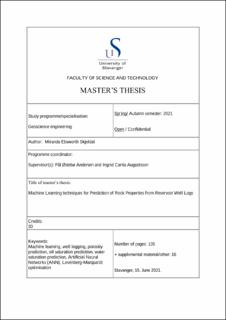| dc.description.abstract | Estimation of reservoir parameters is important in reservoir evaluation and estimation of petroleum volume. Reservoir parameters such as oil saturation, water saturation and porosity are derived from petrophysical logs or time-consuming, expensive core analyses. Not all wells are cored in a field, and the number of fully cored wells and recovery is limited. In this study, a time-efficient and economical method to estimate oil saturation, water saturation and porosity is employed. An artificial neural network (ANN) model, a multilayer feedforward network (MLP) is developed to predict the reservoir parameters. The model is based on 1042 petrophysical log data, oil saturation and water saturation data, and 1697 petrophysical log data and porosity data from five wells in the Varg field, Central North Sea. The MLP model optimised using a backpropagating algorithm, the Levenberg-Marquardt algorithm. In the study, six wells are used in total. The sixth well is excluded from the data set of the calibrated model and employed to validate the performance of the calibrated models. Feature selection is conducted on the petrophysical logs in the study: Gamma-ray, Self-potential, Acoustic, Neutron porosity, bulk density, deep resistivity, and medium resistivity. Feature selection aims to identify the most relevant petrophysical logs and remove those that are considered less relevant. The feature selection is conducted using correlation coefficients and a combination of trial-and-error and a stepwise regression approach. The estimated oil saturation shows a very weak linear (Pearson) and non-linear (Spearman and Distance) correlation (R2 (Pearson) = 0.1, R2 (Spearman)=0.17 and R2 (Distance)=0.11). The estimated water saturation shows weak linear (Pearson) and non-linear (Spearman and Distance) correlation (R2 (Pearson) = 0.29, R2 (Spearman)=0.41 and R2 (Distance)=0.40. The estimated porosity shows moderately strong linear (Pearson) and non-linear (Spearman and Distance) correlation (R2 (Pearson) = 0.67, R2 (Spearman)=0.45 and R2 (Distance)=0.74). The estimated parameters are not fully reliable on data outside the calibrated models data sets range, and the most reliable estimation is the porosity. Increasing the number of wells may increase the data set range and improve the accuracy of the models. For future works, by increasing the number of wells, the models can be employed and tested in other fields. | |
